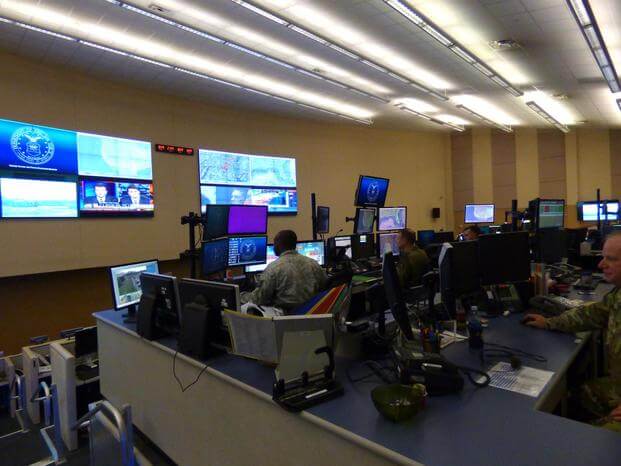The U.S. Air Force continues to execute a significant mission planning and air defense operation from Langley Air Force Base, Virginia, while repairs are ongoing at Tyndall Air Force Base, Florida, following Hurricane Michael.
The 601st Air Operations Center, known as "America's AOC," will remain at Langley until at least the new year, officials announced last week.
The Air Force hopes the center, which plans, directs and assesses air and space operations for the North American Aerospace Defense Command and controls air defense for the continental U.S., will be back at Tyndall by Jan. 1 at the latest, a spokesman said.
"We have enough personnel to maintain our aerospace warning, aerospace control and maritime warning missions out of Langley," Air Force Capt. Cameron Hillier, a NORAD spokesman, told Military.com on Friday. "The missions are being executed the same way they would at Tyndall. Airmen relocated to Langley conduct our core leadership, planning and execution functions."
Related content:
- This Command Center Keeps Air Traffic Away from Mar-a-Lago
- From a Small Center in Florida, Airmen Help Rescue Civilians
- Return of F-22s to Tyndall After Hurricane Undetermined, Air Force Secretary Says
The operations center works with a number of Air National Guard fighter jet units that stay on alert 24/7, including F-15 Eagle, F-16 Fighting Falcon and F-22 Raptor squadrons. It also includes a handful of air refueling tankers and a Boeing E-3 Sentry Airborne Warning and Control System aircraft (AWACS), officials told Military.com last year.
The center also conducts some missile defense operations.
"If Mr. Putin ever decided to send Russian bombers our way, or launch missiles our way, we also do a missile defense portion," said Col. John Ferry, then-601st Air Operations Center commander, in February.
Hillier said operations have been continuous despite the hurricane evacuation and recovery.
"Every adverse situation has challenges that must be overcome. In this case, our entire team at Tyndall has been affected by Hurricane Michael," he said.
But, he added, it will not stifle "Northern Command's ability to conduct its missions of homeland defense, defense support to civil authorities, and theater security cooperation. Homeland defense is the command's number one priority and has not been affected."
A handful of airmen from Tyndall's Air Force Rescue Coordination Center have also moved to Langley, Hillier said.
The RCC is a small unit that falls under 1st Air Force (Air Forces Northern), dispatching resources at the request of state and federal entities, as well as government agencies in Mexico and Canada. It often helps fill the gap when state or local officials don't have the resources to rescue missing persons within the U.S. On occasion, the center will use domestic drone surveillance flights to locate missing people.
Since its inception in 1974 through 2016, the RCC had saved 16,554 people and boasts the highest saves-to-mission ratio of any command in the service, officials said.
The Air Force did not say whether the RCC will return to Tyndall after the base is restored. Officials have said that some airmen and their families will face a permanent change of station before on-base housing is available again.
"By the winter holidays and, in many cases, well before, we expect all our airmen -- military and civilians -- to have certainty about their options, so that everyone is either on a path or already settled," Air Force Chief of Staff Gen. David Goldfein said Friday. "It will take us a while to restore buildings and infrastructure, but returning our airmen and their combat missions to full strength -- at Tyndall or somewhere else in the interim -- will happen quickly."
-- Oriana Pawlyk can be reached at oriana.pawlyk@military.com. Follow her on Twitter at @Oriana0214.










